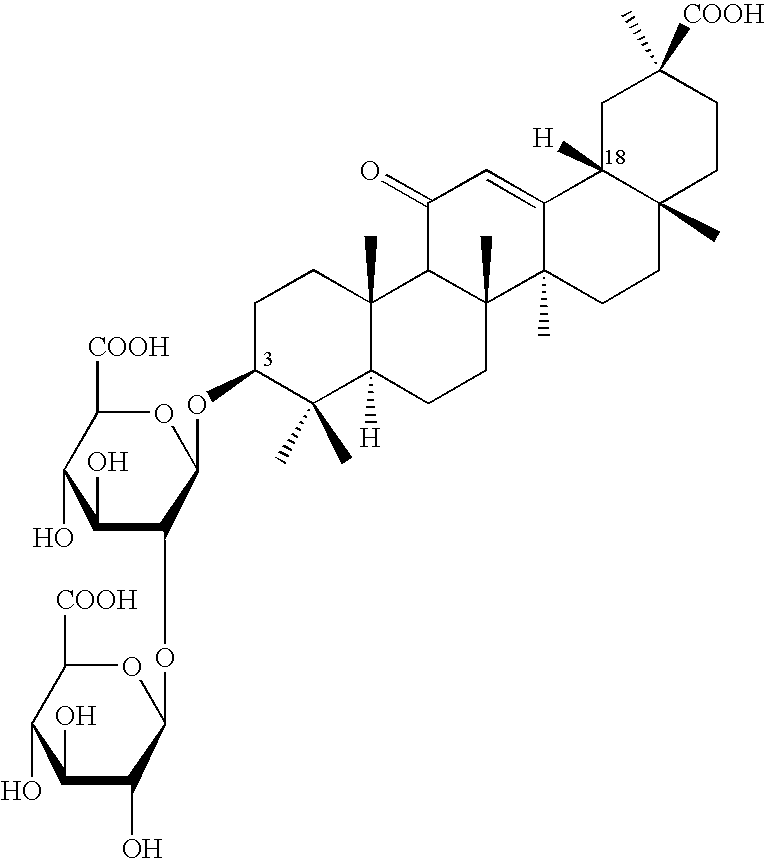Therapeutic agent for mastitis of livestock and method for treating mastitis using the same agent
a technology for livestock and mastitis, applied in the direction of antibacterial agents, antibiotics, drug compositions, etc., can solve the problems of mastitis being one of the most difficult diseases to cure, the most prone to mastitis in cattle, and the most prone to milking, etc., to achieve the effect of reducing human safety problems
- Summary
- Abstract
- Description
- Claims
- Application Information
AI Technical Summary
Benefits of technology
Problems solved by technology
Method used
Image
Examples
examples 1 to 5
A therapeutic composition containing glycyrrhizin shown below was dissolved into water to a final volume of 1000 mL, and its pH and osmotic pressure were adjusted to 6.7 and 2, respectively, in order to prepare a therapeutic agent of the invention. The formulation of the herapeutic composition is shown below.
The therapeutic agent containing 400 mg equivalence glycyrrhizin was administered into the mamma manifesting mastitis using a cannula on day zero of recognition of the disease. The results of treatment were evaluated on day 0, 1 t 3, 7, 14 and 21, which will be described hereinafter. These Results are Shown in Tables 1 to 5.
Formulation of the Composition Containing Glycyrrhizin Therapeutic Agent (High Efficiency Kaneo-Minofagen C)
glycyrrhizin ammonium salt 2.0 g as converted into glycyrrhizinaminoacetic acid20.0 gL-cysteine hydrochloride 1.0 gsodium chloride 5.0 ganhydrous sodium bisulfate 0.8 g
examples 6 and 7
The therapeutic agents corresponding to 400 mg and 800 mg of glycyrrhizin were administered in Example 6 and 7, respectively, into the mamma manifesting mastitis on day zero and on day three after starting the tests. The method of medication and of evaluation of the treatment were the same as those described in Examples 1 to 5. These results are shown in Tables 6 and 7.
(Evaluation of the Results of Treatment)
The results of the treatment were evaluated by clinical observation and test for the milk.
Clinical observations were performed with respect to “Inflation and rigidity of the mammae” and “aggregates in the milk”. The tests of the milk were performed with respect to “degree of coagulation of the milk”, “Judgment by pH of the milk”, “the number of somatic cells in the milk” and “the number of granulocytes in the milk”. The evaluation method is described in the corresponding column.
The evaluation of “degree of coagulation of the milk” and “judgment by pH of the milk” was based on “t...
PUM
| Property | Measurement | Unit |
|---|---|---|
| concentration | aaaaa | aaaaa |
| volume | aaaaa | aaaaa |
| volume | aaaaa | aaaaa |
Abstract
Description
Claims
Application Information
 Login to View More
Login to View More - R&D Engineer
- R&D Manager
- IP Professional
- Industry Leading Data Capabilities
- Powerful AI technology
- Patent DNA Extraction
Browse by: Latest US Patents, China's latest patents, Technical Efficacy Thesaurus, Application Domain, Technology Topic, Popular Technical Reports.
© 2024 PatSnap. All rights reserved.Legal|Privacy policy|Modern Slavery Act Transparency Statement|Sitemap|About US| Contact US: help@patsnap.com








